Knowing Andhra's bid for UNESCO World Heritage Sites
08 Apr 2022 17:01:34
In the recent development, where three Indian heritage sites from Maharashtra, Andhra Pradesh and Meghalaya were counted in UNESCO tentative list, the total of Indian sites in the UNESCO tentative list reached 49, with the three being an addition to the earlier 46 sites. A Tentative List is an inventory of those properties which each State Party intends to consider for nomination. According to the UNESCO norms, states parties are encouraged to submit their Tentative Lists, properties which they consider to be cultural and natural heritage of outstanding universal value and therefore suitable for inscription on the World Heritage List.
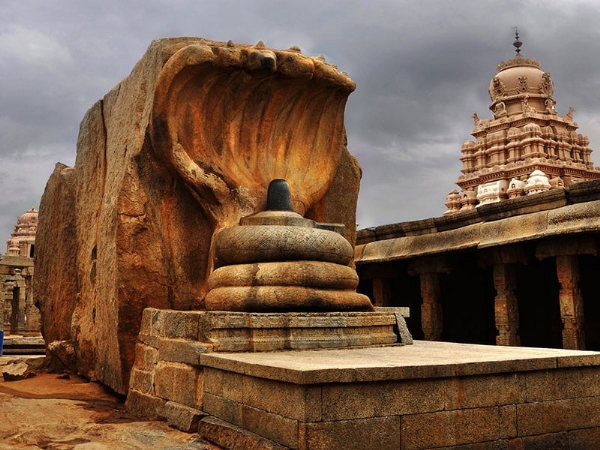
In the last article, we came to know about the ancient heritage of Konkan that is present in the form of Geoglyphs in Maharashtra and Goa. Second in the article series is dedicated to the Sri Veerbhadra Temple or the Lepakshi Temple in the state of Andhra Pradesh.
The Veerabhadra temple, also known as Lepakshi Temple is located in Andhra Pradesh's Lepakshi Village. It is named after the main shrine dedicated to Veerabhadra (the fiery incarnation of Lord Shiva). From the inscriptions engraved on the prakara walls of the temple, the village is alternatively called as Lepaksha, Lepakshi and Lepakshipura. The literal meaning of the word is -'Lepa' and 'Akshi' an embalmed or painted eye. However, due to several stories signifying the meaning of the village's name, it is difficult to understand its origin.
Indian mythology and the Veerabhadra Temple site
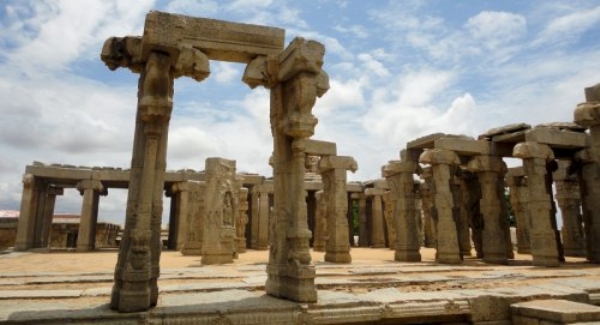
The significance of the place dates back to the Indian epic of Ramayana. It is believed that the bird Jatayu, wounded by the king of Lanka, Ravana, fell here after a battle against the Lankan King, who was carrying away Sita, the wife of Ram, the king of Ayodhya. When Ram reached the spot, he saw the bird and said compassionately to him, 'Le Pakshi' — meaning 'Arise, bird' in Telugu. The roof of the temple is painted with panels of murals depicting scenes from Mahabharata, Ramayana and other Pauranic legends.
Veerbhadra Temple in Indian History
The discovery of Ashokan Rock Edicts at Yerragudi in same district as Lepakshi and other sites as Siddhapur, Jatinga Rameshwaram, and Brahmagiri in the adjacent districts indicates that this region was under Mauryan rule in 3rd Century BCE. From the Mauryans, it came under Satavahanas, Chutus, Gangas, Chalyukas of Badami and the Nolambas. The Nolambas were in possession of the temple till the 10th century CE. From the Nolambas, the temple was passed to the Chalukyas of Kalyani and then to the Hoysalas who ruled till the first quarter of the 13th century CE. In 1346 CE, King Harihara constructed a fort at Penugondaas, that became his second capital marking the start of the Vijayanagara rule over the region.
The development of the temple complex can be classified under three broad phases ranging from 1100 to 1800 CE, based on its architectural advancements. The first phase falls between 1100-1350 CE, during which important architectural features such as pillars, pilasters, and niches developed, which contains features of late Chola, Pandya, and Hoyasala styles and of the early Vijayanagara Period as well. The direct evidence in the form of inscriptions does not provide any information about the early history of temple.
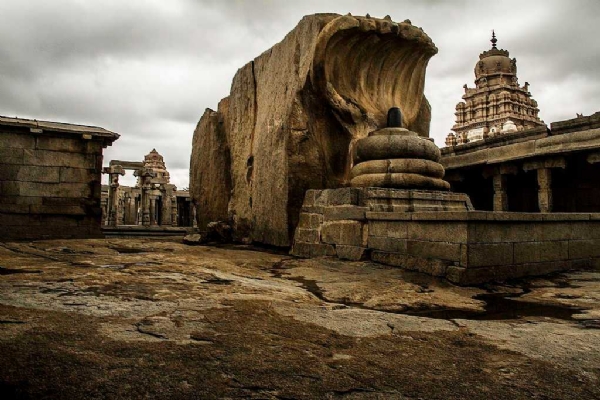
In the next period, major building activity took place from 1350 - 1600 CE representing the period of matured Vijayanagara architecture. During this period, the place was developed into a large complex by adding several shrines and mandapas and multi-pillared mandapas. During the Vijayanagara period, Lepakshi temple went through gradual development in the reign of king Achyutaraya (1529-42 CE) and stood witness to Vijayanagara period at an important stage of its evolution.
The last period falls in between 1600 to 1800 CE during which no significant structure has come except for some minor shrines.
Historic inscriptions at Lepakshi
About 20 inscriptions are engraved on prakara walls of Sri Veerabhadra temple and majority of these belong to the reign of Achyutaraya Maharaya (1539-42 CE). These inscriptions throw light on the historical evolution of the temple complex and donations in each period. The inscriptions are grouped into three phases.
Architecture of Lepakshi Temple
The temple complex along with its concentric enclosure walls or prakara is situated on a low granite tortoise shaped hill known as Kurmasaila. The structures were built at three different levels or contours of the hill; each group was enclosed by three prakaras i.e inner, middle and the outer prakara built during three different phases. It is believed that there were seven enclosure walls similar to that of Hampi, capital of Vijayanagara, since the number is considered as sacred in Indian civilization.
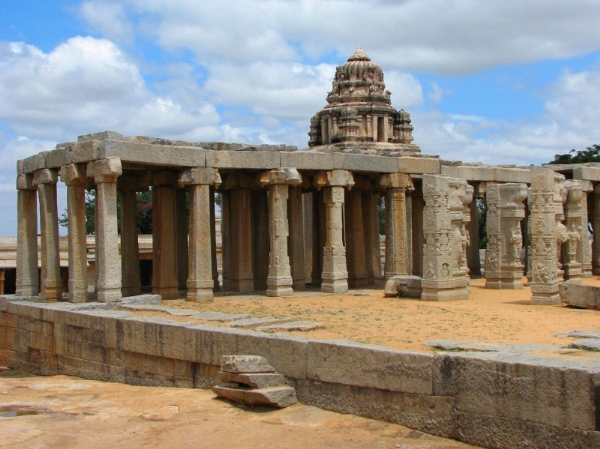
The temple is built in trikuta style, initially with two shrines - Veerabhadra and Papanaseswara sharing a common platform and a pillared maha-mandapa. The third shrine was added on west of the same platform, which together forms a part of inner prakara, dedicated to Raghunatha. A huge granite boulder has been incorporated within the enclosure wall. Natya-mandapa is attached to the Maha-mandapa, common to these three shrines. This is the most ornate structure of the temple.
The second prakara encloses kalyana-mandapa, balipitha, vahana-mandapa and homamandapa. This enclosure covers almost eight times of the area covered by the innermost prakara and has two entrances, one on north and one on south. To the south of the main shrine within the inner prakara there is a huge monolithic sculpture of Ganesa linga worshipped by spider and an elephant in a small mandapa with two pillars known as Ganesa Mandapa.
The temple complex was further extended by construction of water cistern, Somavaramandapa, Yagamandapa, Uyalamandapa which is enclosed by the third prakara. This third enclosure covers two and a half times the area covered by the second prakara. The third prakara has three entrances, one on north, one at east and one at west.
The water cistern at Lepakshi temple is situated at the western side of the prakara adjacent to Uyalamandapa. It is a deep pit excavated into natural rock in an oblong shape. Similar cistern is also available at Hampi.
Sculptures and paintings of the temple
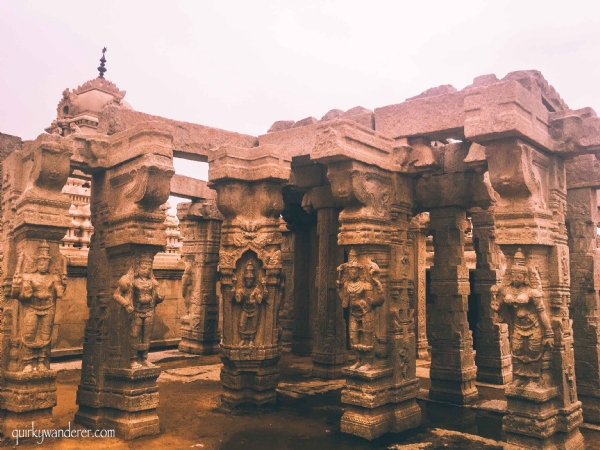
The gigantic bull is a sculpture carved out of a huge granitic rock. This monolithic sculpture is a unique example of its kind. It faces west and is looking towards the mentioned Naga-linga located at Sri Veerabhadra temple. On the eastern face of a granite boulder in second enclosure, is a basaltic sivalinga canopied by a monolithic sculpture of seven hooded Naga.
Sculpture work with different themes from Hindu mythology, pauranic beliefs and traditions, and flora and fauna engraved on the different components of the temple such as pillars, ceiling of mandapas and naturally existing granite boulders contribute to the aesthetic value of the temple. Exquisite examples of monolithic sculptures like Naga-siva-linga, Ganesa and the massive stone engraved footprint (believed to be of Sita) represent the artistic brilliance of that time.
With the support and help of Vijayanagara kings, Krishnadevaraya and Achyutarya created notable development in the field of art in the empire which is distinctly visible in the paintings at Veerabhadra Temple. The technique used is known as Fresco-secco or painting in lime medium on plaster. The fresco paintings on the walls and ceilings of mandapas and pradakshinapada depict illustrations from Ramayana and Mahabharata, gods and legendary stories like Parvathi's marriage, Kiratarjuniyam, different manifestations of Siva, Draupadi Swayamvaram and Virupanna and his brothers worshipping Veerabhadra. After the downfall of Vijayanagara Empire, the paintings remained unattended for long period resulting in damage of the paintings.
Uniqueness of Lepakshi amongst other Dravidian temples
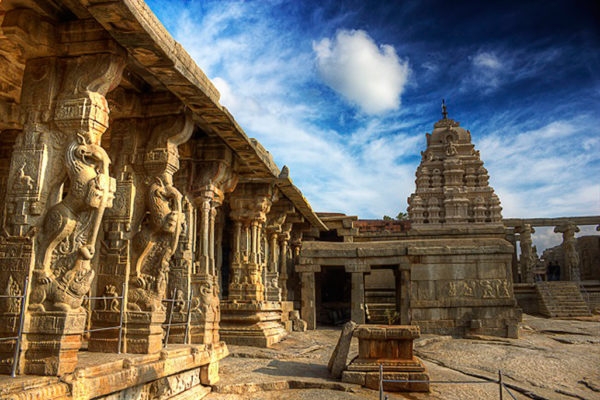
The Veerabhadra Temple and Monolithic Bull (Nandi) is comparable to Kakatiya Rudreshwara (Ramappa) Temple in Telangana, which also represents a masterpiece of human creative genius. Rudreshwara (Ramappa) Temple’s sculptures of high artistic quality illustrate the customs and culture of Kakatiyas along with depicting tales from the Puranic epics that were relevant and celebrated during the era. Similar is the case of Sri Veerabhadra Temple, only distinction being the medium of illustration that has sculpture and fresco paintings both.
Veerabhadra Temple is compared to the Virupaksha temple at Hampi which also houses fresco paintings. Interchange of cultural and artistic values within the same period can be tangibly experienced in the paintings of both sites. What differentiates the fresco paintings at Sri Veerabhadra Temple is the fresco-stucco technique used for the paintings, characterized by locally available earthen colors and representation of characters of each scene with a circular curvature corresponding to the center.
The monolithic sculptures at Veerabhadra Temple like Naga-sivalinga, bull (Nandi) can be compared with Buddha sculpture protected by Naga-Muchalindaof ancient city of Gaya and Lakshmi-Narasimha monolithic bull at Hampi for its scale, unique craftsmanship and the use of material. The Vijayanagara artist proved their competency by carving sculptures on hard material like granite stone.
Lepakshi Temple - a 'World Heritage'
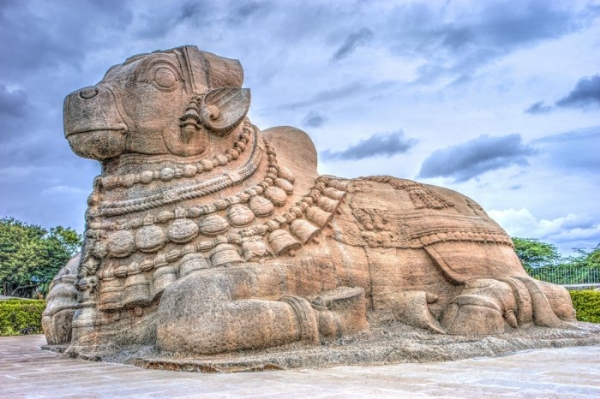
The Veerabhadra temple houses the principle examples of Vijayanagara paintings. The figurative documentation of customs and traditions through pauranic stories and the Mahabharata and Ramayana epics in the sculptures and paintings are invaluable historical evidences and are of cultural significance. With the use of fresco-secco technique, the temple is a masterpiece of creative effort reflecting cultural practices of the time and place of its creation and stand as example for continuity of traditions.
The architectural and ornamental elements such as sculptures; pillars of natya- mandapas elaborately carved with the figures of musicians, gods and goddess, and dancers portray a remarkable concentration of skills of 16th Century artists and crafts workers of South India. The property thus bears a witness to human artistic and creative endeavors of one of the most ancient cultures of the world.
-- The article is based on information provided by UNESCO
